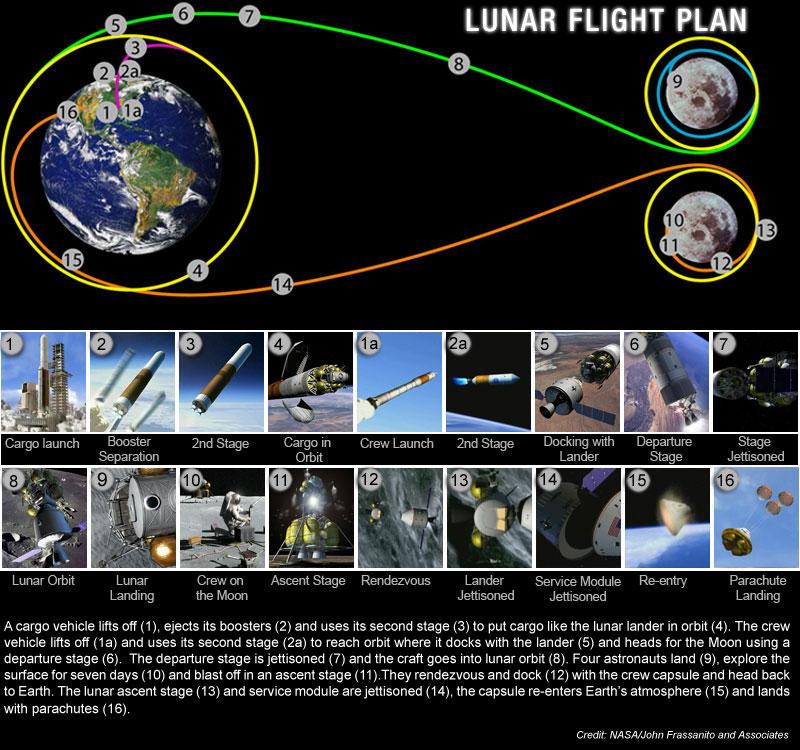This essay gives a historical perspective of what a science reporter has seen and felt about the exploration of space.
The Age of Dreams
I was a teenager
when President Nixon announced,
on January 5tn, 1972:
| I have decided today that the United States
should proceed at once with the development of an entirely new type of
space transportation system designed to help transform the space frontier
of the 1970s into familiar territory, easily accessible for human endeavour
in the 1980s and 1990s.
This system will center on a space vehicle that can shuttle repeatedly from Earth to orbit and back. It will revolutionize transportation into near space by routinizing it. It will take the astronomical costs out of astronautics. [Author’s italics.] In short, it will go a long way toward delivering the rich benefits of practical space utilization and the valuable spinoffs from space efforts into the daily lives of Americans and all people. |
Eleven months later, I was sad when I heard that Nixon had told Apollo 17 astronauts: “This may be the last time in this century that men will walk on the Moon, but space exploration will continue,”(1) Of course, I was sure, Nixon would be wrong since we would be back on the Moon by the 1990s. Sadly enough, the last four Apollo missions were cut for budgetary reasons: the Vietnam war was too much a burden on U.S. Government spending to pursue lunar exploration. Also, the public was no longer interested in astronauts strolling on the Moon.
In 1982, I was thrilled when I read in a U.S. Congress report(2) that NASA was planning 487 Space Shuttle flights between FY82 and FY94. That’s one launch every ten days! The space agency was anticipating 7 flights in FY82, 18 in FY83, 24 in FY84, 34 in FY85, 45 in FY86... With the prodigious capabilities of the Shuttle, what a wonderful world we would be living in soon!
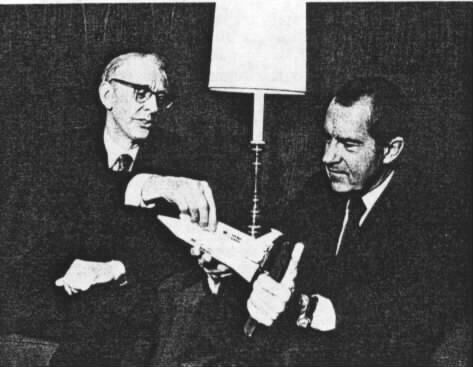
President Richard Nixon and NASA Administrator James Fletcher announced the Space Shuttle program on 5 January 1972.
Then, on the evening of January 25th, 1984, as a young science reporter, I applauded President Reagan when he declared, in his State of the Union Address: “Tonight, I am directing NASA to develop a permanently manned space station and to do it within a decade.”
I then followed
with great interest, and passion, the first flights of Columbia.
Slowly but surely, the Shuttle flight pace accelerated: there were 5 missions
in 1984, 9 in 1985 and 15 were planned for 1986. Of course, this
was far from what NASA had planned only a couple years earlier, but these
missions were very exciting.

This artist's concept illustrates the original Space Station configuration, the dual keel, adopted by NASA in March 1986.
I was devastated on the morning of January 28th, 1986 when Challenger fell from the sky, killing its seven crewmembers (including McAuliffe).
But, again,
I was thrilled when, only a week later, President Reagan announced
in his State of the Union Address:
| So, yes, this nation remains fully committed to America's space program. We're going forward with our shuttle flights, we're going forward to build our space station, and we are going forward with research on a new Orient Express that could, by the end of the next decade [Author’s italics], take off from Dulles Airport, accelerate up to 25 times the speed of sound, attaining low Earth orbit or flying to Tokyo within two hours. |

The X-30 National Aerospace Plane (NASP) concept announced by President Reagan in 1986.
Unfortunately, none of these grandiose visions ever happened.
The Age of Realities
In the 1990s,
no more great presidential initiatives were put forth, as if the time of
such projects was over. Maybe it was time to realize some of the past announcements?
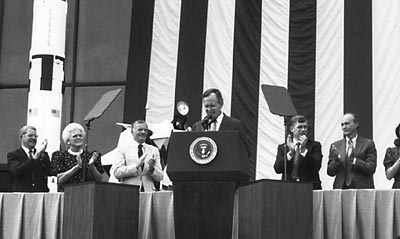
President George Bush proposed a grand space vision, the Space Exploration Initiative, in 1989.
Fortunately,
not all of what happened during this decade was sad, thanks to one major
event: the collapse of the Soviet empire. One of the benefits of this downfall
was the accessibility it provide us to Russian space resources.

Artist's concep of Space Station Freedom.
Maintaining
Mir operations was a tremendous achievement during the chaotic period that
prevailed in Russia during the 1990s. Mir continued to be manned for ten
years (1989-1999). More and more astronauts from countries such as France
and Germany visited it. The secret Russian space program opened up, to
the delight of observers like me.
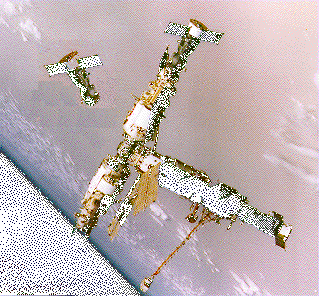
The Mir space complex, the first international space station.
These remarkable
developments were truly unthinkable only a decade earlier, when President
Reagan launched its space station project and its Space Defence Initiative
(nicknamed “Star Wars”).

Orbiter Atlantis docked to the Mir space station was photographed by the Mir-19 crew on July 4, 1995.
In the meantime,
both space powers decided to join forces. United States and Russia had
no more the financial capability to pursue their own projects and thus,
they combined their space station programs. U.S. Space Station hardware
was mixed with Mir-2 modules to form the International Space Station –
the largest scientific and cooperative endeavour ever attempted by humanity.

My first book, "Living in Weightlessnes" was published in 1989.
.
| The International Space Station will allow humankind to harness as never before one of the fundamental forces of nature – gravity – to perform research that may result in new medicines, materials and industries on Earth. When completed, the station will provide more than 60 times as much power to scientific research as was available on the Russian Mir space station. The station's scientific studies, performed in six state-of-the-art laboratories, may even lead to a new understanding of the fundamental laws of nature while they pave the way for the future human exploration of deep space. |
What an exciting time we were living in, I was thrilled.
The Real Fall-out of Columbia
Unfortunately, today, we’re still waiting to see the bright future and benefits announced in the 1970s, 1980s and 1990s.
Thirty-five
years after President Nixon announced the “routinization” of space travel,
only 115 Shuttle missions have taken place, instead of the thousand we
might had hoped for. We’re still waiting to see the revolution of space
industrialization so often claimed. Not much more was heard of the Orient
Express and of the Space Exploration Initiative of former President Bush.
But, I must admit, President Nixon was right when he said “no more astronaut
on the Moon for the rest of the Century.”
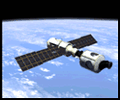
Above: the first two ISS elements assembled in December 1998. Below: ISS at completion (as it was scheduled at that time).
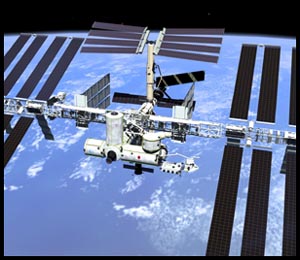
.
| Today, I announce a new plan to explore space and extend a human presence across our solar system... Our first goal is to complete the International Space Station by 2010. We will finish what we have started, we will meet our obligations to our 15 international partners on this project... |
Did I hear correctly?, I asked myself. Are the U.S. “obligations” to their partners only to built ISS? Was U.S. only a “house-builder” and Russia, Europe, Japan and Canada the real tenders and users of the space facility? In the twenty years I followed this project, I had never heard such a thing.
But wait, the
president continued:
.
| We will focus our future research aboard the station on the long-term effects of space travel on human biology… |
I was shocked. Was ISS not to perform “research that may result in new medicines, materials and industries on Earth” (to quote NASA PAO)?
And then, my
jaw fell as the President announced:
.
| In 2010, the Space Shuttle – after nearly 30 years of duty – will be retired from service. |
How could we – U.S. and partners – use ISS facilities without the Shuttle? It’s the only spaceship able to carry tons of cargo up to ISS and, more important, to bring back scientific results and hardware. Without it, ISS is nearly useless, as we see since the loss of Columbia. How could U.S. abandon the station after 2010, and who will be able to operate it, not just maintain it? Nobody, without the Shuttle.
And that’s not the worst news.
In my mind, the fact that President Bush Jr. announced the end of all Shuttle flights by 2010 – instead of at ISS assembly completed – is a terrible threat to both programs.
Remembering
that the pressure to meet a schedule was one of the “contributing factors”
to the Columbia tragedy, I went back to read Section 6,2 of the
Columbia Accident Investigation Board Report. Recommendation
6.2-1 is:
.
| Adopt and maintain a Shuttle flight schedule that is consistent with available resources. Although schedule deadlines are an important management tool, those deadlines must be regularly evaluated to ensure that any additional risk incurred to meet the schedule is recognized, understood, and acceptable. |
Isn’t it the 2010 deadline the ultimate schedule pressure faced today by NASA? What will happen in 2009 or 2010 if NASA needs to fly too many Shuttle to “meet U.S. obligations”? Will we be on the brink of another tragedy?
I truly hope
not, Mr President.

President Bush Jr. announcing his radical revision of U.S. Civilian space program goals.
But, wait,
Mr. Bush is announcing something “big:”
.
| Our second goal is to develop and test a
new spacecraft, the Crew Exploration Vehicle by 2008, and to conduct the
first manned mission no later than 2014. [Author’s italics.] The
Crew Exploration Vehicle will be capable of ferrying astronauts and scientists
to the Space Station after the Shuttle is retired. But the main purpose
of this spacecraft will be to carry astronauts beyond our orbit to other
worlds. This will be the first spacecraft of its kind since the Apollo
Command Module.
Our third goal is to return to the Moon by 2020… Using the Crew Exploration Vehicle, we will undertake extended human missions to the Moon as early as 2015, with the goal of living and working there for increasingly extended periods. |
Since then, NASA has published wonderful artwork (above) of what “Apollo-on-steroids” would look like, that is: Apollo-type lunar spacecraft using 2000 technologies instead of 1960's.
The first lunar missions being planned for the 2015-2020 timeframe, this will be exactly 50 years after original Apollo missions took place. I therefore propose naming this still yet-unnamed program “Apollo+50”, or Apollo at 50. Thus, it will be a tribute to the baby-boomers who saw, as children, the original Apollo lunar landings and who are now dreaming of this second-generation Apollo program.
But, could we expect the VSE to ever take place?
Certainly…
not! In my mind, there are many reasons to be sure of that.

The new "Apollo project" announced by George Bush Jr.: an Apollo-type Crew Exploration Vehicle (left) docked to an augmented Lunar Module.
The first and obvious reason is that, except for Kennedy’s goal for “A man on the Moon before the end of this decade,” none of the Presidential visions were realized. So, how could we expect that the VSE be the second exception?
In fact, this vision suffers from the same flaw that plagued the others, mainly its lack of a precise goal to be accomplish in a strict, short period – “before this decade is out”, as Kennedy once said. (Even Reagan’s 1984 space station failed to be built by 1992, as planned.)
There is also the “Apollo 12” syndrome. Supposed NASA succeed to develop the hardware needed to return to the Moon. We may guess that each of these Apollo+50 mission will cost some 1 or 2 billion $ apiece. How many such missions U.S. Congress and American taxpayers will accept to pay for? Could we fear that, as in the case of Apollo, they will at best finance the first two or three (just to prove that we are again able to go to the Moon) and then stop because “nobody cares anymore that astronauts walk on the Moon”? That’s exactly what happened after Apollo 12.
Will the President in Office at that time be forced to announce another exciting program? “Let’s go to Mars with an entirely new technology that, by the way, will revolutionize how we do things in Earth orbit and on Earth too…”
Personally, I’m sure we will never return to the Moon in the next decade because U.S. will not be able to afford Apollo+50 after Bush Jr. leaves office. The Iraq war is too much a burden on U.S. spending, as was the Vietnam war in the 1970s. More important, the “astronomical” debt cumulated by the Bush Administration could bankrupt the nation. Bush’s successor will be force to take energetic actions to redress U.S. Government finances. One of the first casualties will be… Apollo-on-steroids.
But what should we do now? Stop all space exploration projects and jump from a bridge?!
May I suggest: a) stop dreaming and, b) try to learn the lessons from past experiences?
Of course there are many lessons to extract from the Space Shuttle fiasco, the fact that this fabulous machine cost so much and flew so little. There are as many from the misfortune of the Space Station, so many times redesigned, rephrased, reorganized, delayed again and again, and finally abandoned half-built!
What happened in the last three decades that caused tens of billions $ to be wasted in the Shuttle program as well as in ISS?
There are many
important lessons to be learned and applied. But I’m not an expert
in that area. I’m just a reporter… who will be glad to report these
lessons!
Claude Lafleur is a science reporter who covers space activities for Quebec’s French news media. He is the author and editor of The Spacecraft Encyclopedia which presents a comprehensive census of all spacecrafts ever launched,
Notes:
| (1) | For a discussion by Apollo 17 astronauts on the "strange" Nixon announcement, see entry "169:50:43" (above) in the Apollo 17 Lunar Surface Journal. |
| (2) | United States Civilian Space Program, 1958-1978, Congressional Research Service, Volume 1 (January 1981), p. 529 and 533. |
| (3) | Launch of the International Space Station Zarya and Unity, NASA ISS Press Kit, November 1998, p. 1 |

